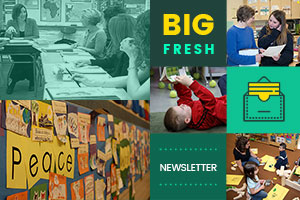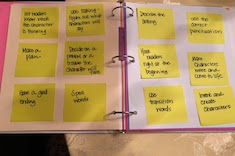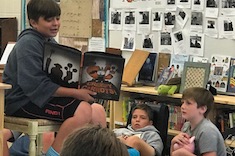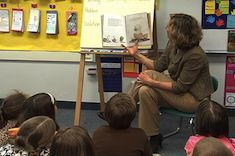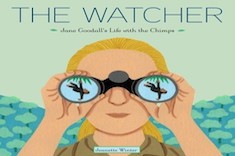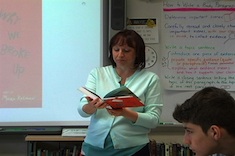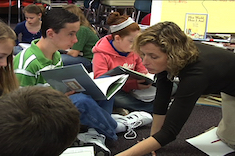Library
Choice Literacy Articles & Videos
The Choice Literacy library contains over 3,000 articles and 900 videos from 150+ contributors. Classic Classroom and Literacy Leadership subscribers have access to the entire library. Content is updated continuously, with five to six new features published each week.
Latest Content
September 27, 2019 Two Wolves
Developing confidence in teachers and students is the focus of this week’s newsletter.
Raising Student Voices: Mentor Texts
Helping students find and raise their voices so that they can someday change the world is one of the most important things we do. Cathy Mere shares some of her favorite mentor texts for this essential work.
September 20, 2019 Leave It
We share some tips for organizing and leading better groups in this week’s newsletter.
Building Reading Skills Book to Book: Conferring with Bridget
Christy Rush-Levine confers with eighth grader Bridget, coaxing her to compare and contrast the reading experience and plot twists in books.
Boosting the Confidence of Writers
We can teach students craft moves for their writing and how to punctuate. But how do we build their confidence? Melanie Meehan helps Aaron see his needs as a writer, but even more importantly, his strengths.
Owl Research: Getting Organized
Andrea Smith checks in on a group of boys who are doing research into owl habitat, helping them organize their work and plans.
The Power of Video Replay
Heather Fisher explains how viewing excerpts from the same video multiple times can help students in book clubs hone their conversation and reflection skills.
Book Club Tools
Tammy Mulligan shares the importance of giving students choice and agency with book club tools to improve engagement and the quality of the conversations.
September 13, 2019 Lingering a Little
We conclude our three-week series on read-alouds in this week’s newsletter.
Moving from Interactive Read Alouds to Book Clubs
Tammy Mulligan shares how teachers can move seamlessly from thoughtful conversations during whole-class read alouds to lively book clubs.
September 6, 2019 Evoking Book Memories
We continue our three-week series on read-alouds in this week’s newsletter.
Do Students Need to Love the Books We Read Aloud?
Franki Sibberson asks a critical question: Do students need to love the read alouds we share in classrooms? She works to move students beyond shallow like/don’t like responses to books.
Introducing Social Studies Concepts with Picture Books
Mark Levine explains how picture books are powerful teaching tools in his middle school classroom.
Read Aloud in Middle School
Katherine Sokolowski values read aloud for her middle school students and struggles to find time for them. Her solution? A picture book a day, better known as the #bookaday activity.
Grand Conversations and Read Aloud
Are your conversations during read aloud stilted or shallow? Tammy Mulligan recommends weekly “grand conversations” to spark more thoughtful talk. She provides the tools you need to get started in your classroom.
August 30, 2019 Farm Share
We begin a three-week series on read-alouds in this week’s newsletter.
August 23, 2019 Blank Canvas
We explore the use of anchor charts in this week’s newsletter.
Reading and Thinking Aloud in Middle School
Mark Levine combines reading and thinking aloud in a minilesson to help his middle school students grapple with complex texts.
First-Grade Read Alouds During Transitions
This brief video is an excerpt from a read aloud in a first-grade classroom during morning snack break. You’ll notice Bitsy Parks uses a projector so students can eat at tables and desks, and makes quick connections to other books.
Jane Goodall Inquiry: Introducing Expectations
Katherine Sokolowski introduces her students to routines and expectations early in the year with a unit on Jane Goodall, including many short read alouds.
Back-Channel Conversations During Read Alouds
Christy Rush-Levine considers some of the “underground” ways in which she converses about books at conferences and on social media, and decides to set up a back channel for similar conversations about read alouds in her classroom.
Interactive Read Aloud and the Whole-Class Notebook
Tammy Mulligan enhances the quality of the class read aloud and student discussions with the use of a whole-class response notebook.
Charting Mentor Texts
Tara Barnett and Kate Mills share many of their favorite anchor charts for helping students connect writer’s craft to mentor texts.
A New System for Anchor Charts
Dana Murphy develops a love-hate relationship with the faded anchor charts peeling away from her classroom walls. She finds a move to anchor charts in a sketchbook and a website for chart images improves the quality of her charts and their usefulness.
August 16, 2019 We Know How
We consider our youngest learners in this week’s newsletter.
The Curious Incident of Poem in the Stream of Time
Shirl McPhillips shares a haunting poem and reflection on creativity, summer’s inspiration, and aging.
Young Learners and Self-Talk
Do you have young readers and writers in your class who constantly talk to themselves? Stella Villalba helps a teacher decode the value of this self-talk for first grader Kayla, using it as a springboard for more learning.
August 9, 2019 Reading the Signs
We look at a favorite tool for teachers in literacy workshops, status of the class, in this week’s newsletter.
Spacing Words: Kindergarten Small Group
Tammy Mulligan uses another kindergartner’s writing as a mentor text for teaching young children how to use spaces in their writing in this demonstration small group.
Drawing and Learning in Kindergarten
Max Brand demonstrates basic drawing strategies early in the year, and then has his kindergartners attempt similar pictures. He explains how the exercise builds basic skills both in literacy and hand/eye coordination.
Browse Content By
Type
Category
- Assessment Tools
- Big Fresh Archives
- Booklists
- Choice Numeracy
- Classroom Design
- Common Core
- Community Building
- Conferring
- Content Literacy
- Digital Literacy
- English Language Learners
- Equity
- Family Relations
- Free Samples
- Guiding Groups
- Leadership
- Literacy Coaches
- Mentor Texts
- Minilessons
- New Teacher Mentors
- Podcasts
- Poetry
- Quote Collections
- Reading Strategies
- Self Care
- Struggling and Striving Learners
- Talking and Listening
- Teacher Study Groups
- Teaching Reading
- Teaching Writing
- Word Study and Vocabulary
Author
- Melissa Quimby
- Nawal Qarooni
- Gwen Blumberg
- Julie Cox
- The Lead Learners
- Hannah Tills
- Josie Stewart
- Ruth Metcalfe
- Mallory Messenger
- Becca Burk
- Jodie Bailey
- Vivian Chen
- Mary Brower
- Tiffany Abbott Fuller
- Stephanie Affinito
- Ruth Ayres
- Leigh Anne Eck
- Heather Fisher
- Shari Frost
- Julie Johnson
- Suzy Kaback
- Gigi McAllister
- Shirl McPhillips
- Melanie Meehan
- Cathy Mere
- Debbie Miller
- Tara Barnett and Kate Mills
- Tammy Mulligan
- Dana Murphy
- Bitsy Parks
- David Pittman
- Brenda Power
- Heather Rader
- Matt Renwick
- Mandy Robek
- Christy Rush-Levine
- Gretchen Schroeder
- Jen Schwanke
- Brian Sepe
- Katherine Sokolowski
- Stella Villalba
- Jennifer Vincent
Grade Level
Choice Literacy Membership
Articles
Get full access to all Choice Literacy article content
Videos
Get full access to all Choice Literacy video content
Courses
Access Choice Literacy course curriculum and training

